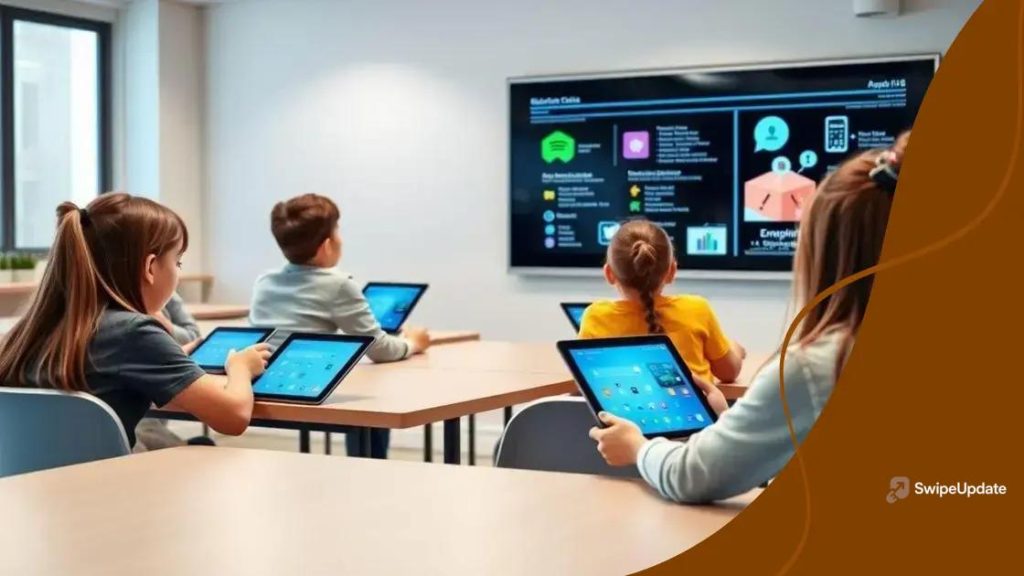Classroom technology: transforming learning environments

Classroom technology enhances learning by engaging students, personalizing education, and providing access to a wealth of resources, while also presenting challenges such as access equity, the need for training, and managing distractions.
Classroom technology is changing the way students learn and interact with content today. Have you ever wondered how tech influences classroom dynamics? Let’s dive into the innovations shaping learning experiences.
Understanding classroom technology
Understanding classroom technology is essential for educators and students alike. This technology is meant to enhance learning experiences, making education more engaging and effective.
Types of Classroom Technology
There are various types of tools that can be used in the classroom. They help facilitate learning in different ways, including:
- Interactive whiteboards that allow for dynamic lessons.
- Tablets and laptops for personalized learning.
- Learning management systems to track progress.
- Virtual reality to enhance immersive learning experiences.
It’s important to choose the right technology for your classroom based on the needs of your students. By integrating valuable tools, educators can also foster collaboration and communication among students.
Benefits of Using Technology
The use of classroom technology offers numerous benefits. For instance, it can:
- Encourage student engagement and participation.
- Support diverse learning styles with multimedia resources.
- Provide immediate feedback through assessment tools.
- Expand learning opportunities beyond the classroom.
Utilizing technology allows teachers to create an interactive learning atmosphere. This, in turn, leads to better retention of information and improved academic performance.
As we continue to explore the various aspects of classroom technology, it’s clear that these tools play a crucial role in shaping future-ready learners.
Benefits of integrating technology in education
Integrating technology in education brings numerous benefits that can enhance both teaching and learning experiences. Teachers and students alike can experience a more interactive environment.
Enhanced Engagement
One major benefit is that technology promotes greater engagement. Students are often more interested when lessons involve technology such as videos, games, or interactive activities. This excitement can lead to increased participation in class.
Personalized Learning
Another advantage is the ability to personalize learning. Technology allows educators to tailor lessons to fit individual student needs. With adaptive learning platforms, each learner can progress at their own pace, ensuring no one is left behind.
- Students can access resources that match their learning styles.
- Teachers can track progress and adjust methods accordingly.
- Learning becomes more fun and relevant to their lives.
Furthermore, integrating technology fosters better communication. Platforms like discussion boards help students collaborate and share ideas beyond the classroom. They can work together on projects, even from different locations, building essential teamwork skills.
Access to Resources
With technology, the wealth of knowledge available is unparalleled. Students can access online libraries, educational videos, and research articles at any time. This availability encourages them to explore topics of interest more deeply.
Having these resources at their fingertips helps students take ownership of their learning process. Expanding what they learn outside the textbook opens new horizons for creative thinking and innovation.
The integration of technology in education ultimately prepares students for a technology-driven world. By understanding and utilizing these tools, they are better equipped for future challenges.
Effective tools for modern classrooms

Effective tools for modern classrooms can greatly enhance the learning experience. With the right technology, educators can create engaging lessons that cater to diverse learning styles.
Interactive Whiteboards
One of the most impactful tools is the interactive whiteboard. This allows teachers to present lessons dynamically. Students can participate by solving problems directly on the board, making learning more engaging.
Learning Management Systems
Learning Management Systems (LMS) also play a crucial role in modern education. They provide a centralized platform where students can access course materials, submit assignments, and communicate with teachers. This accessibility improves organization and fosters independent learning.
- Teachers can track student progress and performance.
- Students can review lessons and materials anytime.
- LMS often include forums for discussion, enhancing collaboration.
Additionally, educational apps are becoming popular in classrooms. These apps can cover various subjects and skill levels, providing students with personalized content. Many apps include interactive elements like games and quizzes, making learning fun.
Digital Collaboration Tools
Digital collaboration tools are vital for group projects. Platforms like Google Classroom or Microsoft Teams enable students to work together in real time, regardless of their physical location. This not only develops teamwork skills but also prepares students for the digital workplace.
Furthermore, using classroom technology promotes critical thinking. Students can research topics online, analyze information, and create presentations that showcase their findings. This process encourages deeper understanding and engagement with the subject matter.
With these effective tools, modern classrooms can foster a more enriching educational environment. When technology and teaching methods blend well, students thrive and are better prepared for future challenges.
Challenges of using technology in schools
While using technology in schools offers many benefits, it also presents several challenges that educators must navigate. These challenges can impact the effectiveness of technology integration in the classroom.
Access and Equity
One major challenge is ensuring access to technology for all students. Some students may not have devices or reliable internet at home, leading to disparities in learning opportunities. Schools must find ways to provide equal access to resources, which may require funding or partnerships with local businesses.
Training and Support
Educators often face difficulties when it comes to training and support for new technologies. Teachers need proper training to effectively integrate these tools into their classrooms. Without ongoing professional development, they may feel overwhelmed or unsure how to utilize technology to its fullest potential.
- Limited training can lead to frustration among teachers.
- Support staff may be insufficient to address technology issues.
- Teachers may struggle with changing their teaching methods in a tech-centric environment.
Additionally, the fast pace of technological advancements can make it hard for teachers to stay updated. With new tools and platforms emerging constantly, continuous learning becomes essential for effective teaching.
Distraction in the Classroom
Another challenge is managing digital distractions. With the internet at their fingertips, students may find it easy to stray from educational content. Teachers need strategies to maintain student focus while using technology. Setting clear guidelines about appropriate use and fostering a classroom culture of responsibility is vital.
Moreover, integrating technology can sometimes lead to over-reliance on digital tools. Students may miss out on essential skills, such as critical thinking and problem-solving, if technology is always used to provide answers. Striking a balance between using technology and traditional methods is crucial.
By recognizing these challenges, schools can work towards effective solutions that enhance technology integration. Addressing issues related to access, training, and classroom management will ultimately support better learning outcomes for students.
Future trends in classroom technology
Future trends in classroom technology promise to reshape how we think about education. As technology evolves, classrooms are likely to become more interactive, personalized, and efficient.
Increased Use of Artificial Intelligence
One significant trend is the rise of artificial intelligence (AI) in education. AI can provide personalized learning experiences, adapting to the needs of individual students. For instance, AI-powered tutoring programs can identify areas where a student struggles and offer tailored practice.
Virtual and Augmented Reality
Virtual reality (VR) and augmented reality (AR) are also set to play a major role in classrooms. These technologies can create immersive learning environments where students can experience history, science, or geography in a hands-on way. Imagine walking through ancient Rome or observing a human cell in 3D!
- VR can help in teaching complex subjects through experiential learning.
- AR can enhance textbooks with interactive elements that grasp student attention.
- These technologies support visual learning, benefiting all students.
Moreover, mobile learning is becoming increasingly popular. Students can learn anytime and anywhere through their devices. This accessibility encourages self-paced learning, fostering independence and responsibility.
Data-Driven Decisions
As data collection becomes more sophisticated in education, teachers will increasingly rely on analytics to inform their teaching strategies. Real-time assessment data can track student performance, allowing educators to adjust their approaches as needed. This enables smarter, more informed decisions regarding coursework and interventions.
With the integration of these advanced tools and methodologies, classrooms will not only keep pace with technological advancements but will also empower students to take charge of their learning journey. These shifts in classroom technology will create a more engaging and effective learning environment for future generations.
In conclusion, the integration of technology in classrooms is not just a trend; it is an essential part of modern education. As we look to the future, we can expect innovative tools like AI, VR, and data-driven methods to become commonplace. These advances will help create engaging, personalized, and effective learning environments for students. By embracing these changes, educators can ensure that students are well-prepared for the challenges of the future while fostering a love for learning. Each step towards implementing these technologies leads to a brighter educational landscape, benefiting both teachers and students alike.
FAQ – Frequently Asked Questions about Classroom Technology
What are the main benefits of using technology in the classroom?
Using technology enhances student engagement, personalized learning experiences, and access to vast educational resources.
How can teachers ensure that all students have access to technology?
Schools can provide devices, partner with local businesses for resources, and explore community programs to improve access.
What role does AI play in modern education?
AI helps personalize learning by adapting content to meet individual student needs, offering personalized tutoring and resources.
What challenges do educators face when integrating technology?
Challenges include ensuring equitable access, providing adequate training, managing classroom distractions, and keeping pace with technological advances.
